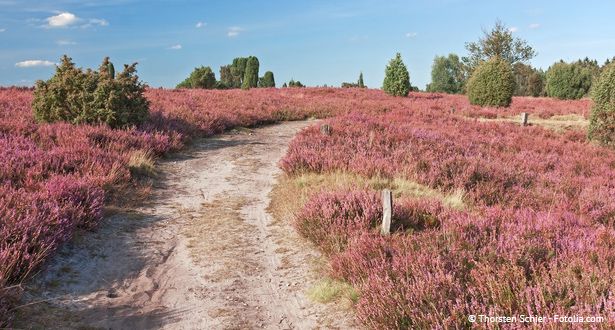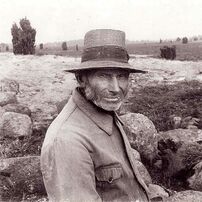Timeline of heathland development
From the time of the Weichselian and Saale glaciations to the 21st century, a quick trip through the history of the development of Lüneburg Heath.
Weichselian and Saale glaciations: 230,000 to 14,500 years before present
Ice sheets are the sculptors of the heathland. Ice sheets and gravel deposits set the landscape in motion for a period of 230,000 to 14,500 years before present. The topographical profile was created by a glacial series during the Weichselian and Saale glaciations. Ice sheets deposit sand and gravel. Melt water sediments are always overlain by new glaciers and compressed into hill ridges. This was how the main hill range of Wilseder Berg was formed.
During the Weichselian glaciation, the Saale moraines are degraded, resulting in dry valleys, shifting sands and inland dunes, and gravel deposits in the river valleys. The finer soil components are redistributed by rain, melting water and wind; today's topographical profile is formed. The erratic boulders which are still found throughout the region are witness to these ice ages.
Glacial erratics, immigrants from the far north
Even today, there are witnesses to the ice age, namely the erratic boulders, which are still found everywhere on the heathland. They have a long journey behind them and come from Scandinavia. They weigh up to 300 tons and are usually made of granite. They have been used for burial mounds, path and road construction, for field walls and the bases of churches and other buildings.
The forest is created
The glaciers melt away, forming a tundra landscape. With increasing warming, open forests are formed: first comes birch, pine, aspen and goat willow, then oak and alder, and finally beech.
11,500 to 3,300 BC
Man takes over, heathland develops
During the Neolithic age (11,500 to 3,300 BC), men settled in the area and influenced the landscape development. Through grazing and clearing they increasingly pushed the forest back. In the Middle Ages man begins to practice sedentary agriculture. The historical heathland farming economy developed and the growth of heathland accelerated. The predominantly dry and sandy soil of Lüneburg Heath offers heathland plants an optimal nutrient base.
Historical heathland farming economy: a perfected cycle
The historical heathland farming economy is an ingenious and sustainable system of nutrient collection and nutrient enrichment. Because of the heathland’s nutrient-poor soils, the few existing nutrients were collected from a large area and concentrated on relatively small fields so that cereals could have any chance to grow. From the Middle Ages, this has been gradually perfected by the regular removal of the heathland topsoil (known as plaggen), which was used as bedding in the German grey heath (Heidschnucke) sheep stables. This was later applied to the fields as fertilizer, having been enriched with the excrement and urine of the sheep.
By means of the so-called plagging cutting for the removal of the upper layers, the regeneration force of the soils was gradually exhausted, which led to the spreading of heather. The subsequent extinction and the associated decomposition of this heath produce the result that the pH value of the soil decreases drastically. A redistribution of organometallic compounds, the so-called podsolization, takes place by oozing water from the upper to the bottom.
This process is detrimental to soil life, which in turn can lead to a hardened or impermeable soil layer - the so-called local stone - below the root layer of the heathland at a depth of approx. 40 cm.
The bottom thus basically separates itself from the acid entry from the upper soil. From the upper part of the soil, the nutrients are largely washed out, which leads to a bleaching process which causes the typical grey-white hiking trails of the heath. For trees, the necessary nutrients had been lacking since then, and the soil was too firm for the roots from a certain depth, so that forest areas became increasingly rare.
From the middle of the 18th century
The heathland reaches its greatest extent
In the middle of the 18th century the heathland reached its greatest extent. But competing products for honey and Schnucken (German grey heath) wool force the heathland farmers over the following decades to overuse their land. There is erosion and desertification of heathland. Artificial fertilizers and the cultivation of potatoes gradually change the agricultural landscape. By the end of the 19th century, many heath areas are reforested.
Early 20th century
The Heath is placed under protection
In 1909, the Verein Naturschutzpark was founded and bought the first areas around Wilseder Berg to conserve the existing heathland.


![[Translate to Englisch:] Siegel: Europäische Union – Europäischer Fond für regionale Entwicklung.](/fileadmin/_processed_/d/6/csm_europaeische-union-fond-regionale-entwicklung-logo_50eda43563.gif)
![[Translate to Englisch:] Logo Europa für Niedersachsen.](/fileadmin/_processed_/b/e/csm_europa-fuer-niedersachsen-logo_7b3947c73c.gif)
![[Translate to Englisch:] Logo Leader.](/fileadmin/_processed_/c/5/csm_leader-logo_c9a57e9ee0.gif)
![[Translate to Englisch:] Siegel: Europäische Union – Europäischer Landwirtschaftsfond für die Entwicklung des ländlichen Raums.](/fileadmin/_processed_/4/7/csm_europaeischer-landwirtschaftsfond-logo_ce24e54bf4.gif)
![[Translate to Englisch:] Logo touristischer Partner Lüneburger Heide.](/fileadmin/_processed_/4/3/csm_lueneburgerheide_positiv-mit-schatten_logo_00411b91a8.gif)